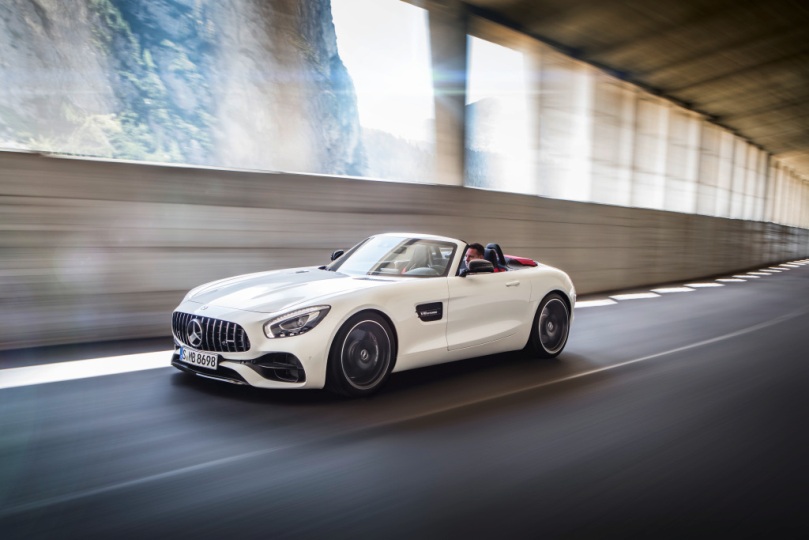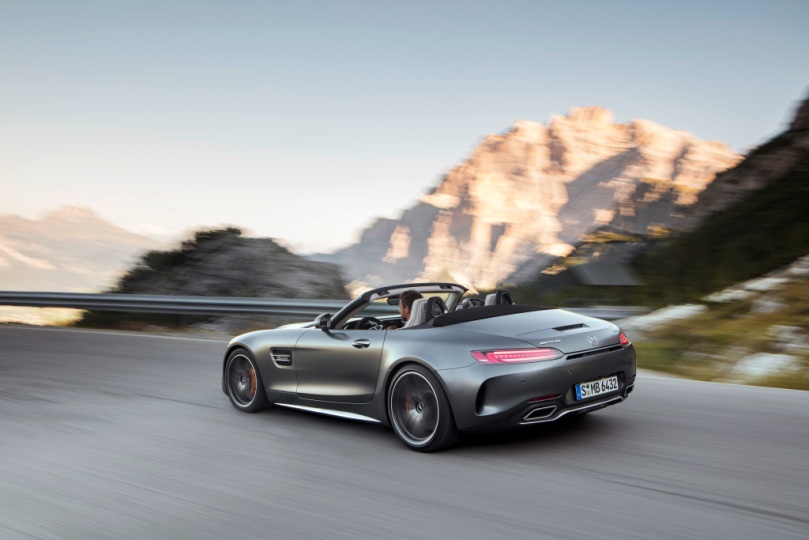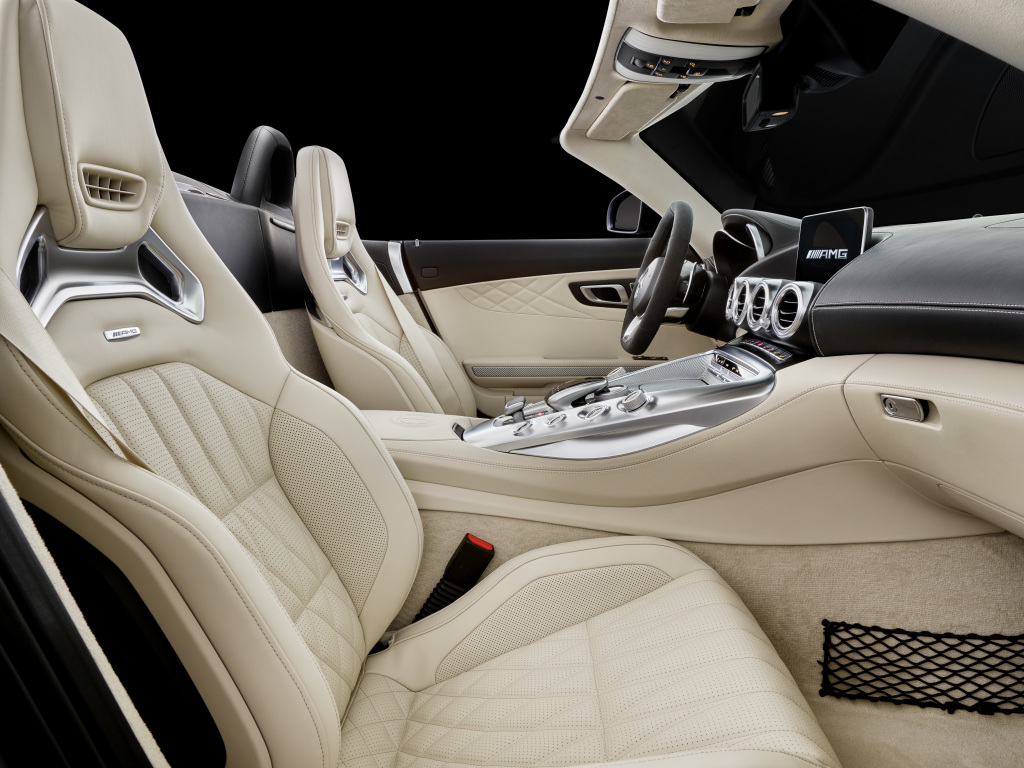
Mercedes-AMG is blowing even more fresh air into the AMG GT family. Shortly after the world premiere of the AMG GT R, the sports car and performance brand from Affalterbach is presenting two exciting roadster variants of the two-seater sports car.
Alongside the AMG GT Roadster*, the AMG GT C Roadster* enhances the portfolio with a completely new model variant. With an output of 410 kW (557 hp) and peak torque of 680 Nm, the AMG GT C is the most powerful new Roadster variant and uses some of the technical refinements of the AMG GT R.
These include active rear axle steering and the electronically controlled rear axle locking differential. In combination with the AMG RIDE CONTROL sports suspension, the AMG GT C Roadster guarantees dynamic performance at the highest level.
The top Roadster also takes its lead from the top AMG GT R sports car where muscular proportions are concerned: the wider rear wings create space for a wider track and wider wheels at the rear axle, allowing even higher cornering speeds and best traction.
The variable performance exhaust system also ensures an authentic V8 sound from the AMG Roadster. The new Roadsters make hallmark AMG driving performance an even more intensive experience.
“With our two Roadster models, we are strategically expanding the AMG GT family by two exciting variants. With the AMG GT C Roadster, we are also introducing a new model variant to which we have transferred main performance-related components from our top sports car, the AMG GT R. The result: a highly dynamic driving experience in a very exclusive ambience, coupled with that pure roadster feeling,” says Tobias Moers, Chairman of Mercedes-AMG GmbH.
*Fuel consumption, combined: 11.4 – 9.4 l/100 km; CO2 emissions, combined: 259 – 219 g/km
With the two Roadster variants, the Mercedes-AMG GT family has now increased to five members. The two new sports cars with fabric soft tops likewise have the technical genes for which AMG is famous.
These include e.g. the lightweight and torsionally rigid aluminium bodyshell plus powerful and efficient V8 biturbo engines. The entry level into the Roadster world is the AMG GT with an output of 350 kW (476 hp). The GT C Roadster adds a completely new output level. With 410 kW (557 hp) it is the more powerful of the two new open-top sports cars.
Technical data at a glance:
| Mercedes-AMG GT Roadster | Mercedes-AMG GT C Roadster | |
| Engine | 4.0-litre V-8 with twin turbochargers and direct injection | 4.0-litre V-8 with twin turbochargers and direct injection |
| Displacement | 3982 cc | 3982 cc |
| Output | 350 kW (476 hp) at 6000 rpm | 410 kW (557 hp) at 5750-6750 rpm |
| Peak torque | 630 Nm at 1700-5000 rpm | 680 Nm at 1900-5750 rpm |
| Drive system | Rear-wheel drive | Rear-wheel drive |
| Transmission | AMG SPEEDSHIFT DCT 7-speed dual-clutch transmission | AMG SPEEDSHIFT DCT 7-speed dual-clutch transmission |
| Combined fuel consumption | 9.4 l/100 km | 11.4 l/100 km |
| Combined CO2 emissions | 219 g/km | 259 g/km |
| Efficiency class | G | G |
| Weight (DIN/EC) | 1595 kg* / 1670 kg** | 1660 kg* / 1735 kg** |
| Power-to-weight ratio | 3.35 kg/hp | 2.98 kg/hp |
| Acceleration 0-100 km/h | 4.0 s | 3.7 s |
| Top speed | 302 km/h | 316 km/h |
| Rear-axle limited-slip differential | mechanical | electronically controlled |
| Suspension | AMG sport suspension | AMG RIDE CONTROL sport suspension with adaptive adjustable damping |
| Wheels front/rear | 9.0 J x 19/11 J x 19 | 9.0 J x 19/12.0 J x 20 |
| Tyres front/rear | 255/35 R 19 / 295/35 R 19 | 265/35 R19 / 305/30 R 20
|
| Brake discs front/rear | 360 mm/360 mm | 390 mm/360 mm |
| Transmission modes | four: C, S, S+, I | five: C, S, S+, I, RACE |
* Kerb weight according to DIN, not including driver;
** Kerb weight according to EC, including driver (75 kg)

The AMG GT C Roadster not only delivers more output and torque, it also impresses with numerous technical highlights from the Mercedes-AMG GT R for even more dynamic performance.
Like the AMG GT R, the AMG GT C Roadster is recognisable by its wide, muscular rear end and large wheels. Other technical measures include the wider rear track and active rear axle steering.
The AMG GT C Roadster is also equipped with a lithium-ion battery, and has more exclusive appointments. Standard features include a nappa leather interior, the AMG performance steering wheel in nappa leather/DINAMICA microfibre and the additional transmission mode RACE.
Fully automatic: the weight-optimised fabric soft top
Both Roadsters are quickly transformed from coupés to open-top sports cars. The fabric roof opens and closes in around eleven seconds, and can do this at speeds of up to 50 km/h. The three soft top colours black, red and beige can be chosen to suit the eleven exterior and ten interior colours.
The three-layered fabric soft top is supported by a magnesium/steel/aluminium structure of low weight, which helps to keep the centre of gravity low. Additional rollover protection is provided by an integrated aluminium cross-member with rollover bars.
New output level: the AMG 4.0-litre V8 biturbo engine
With the AMG GT C Roadster, Mercedes-AMG is introducing a further output level of the 4.0-litre V8 biturbo, thereby underlining the exclusive character of the new model. At 410 kW (557 hp), the peak output is 35 kW (47 hp) above that of the AMG GT S and 20 kW (28 hp) below the Mercedes-AMG GT R.
The maximum torque of 680 newton metres is available from 1900 to 5750 rpm. A sprint from zero to 100 km/h is absolved in 3.7 seconds, and this fulminating acceleration only ends at the top speed of 316 km/h.
The AMG GT Roadster has an output of 350 kW (476 hp) and 630 Nm of torque. This variant accelerates to 100 km/h in 4.0 seconds, and has a top speed of 302 km/h.
The eight-cylinder engine thrills with its immediate response, a linear, finely controllable power delivery and powerful acceleration in all rpm ranges. The AMG 4.0-litre V8 comes with well-proven twin turbocharging, with the two chargers not located outside on the cylinder banks, but rather between them in the V of the cylinders.
The advantages of the “hot inner V”: a compact engine design, spontaneous response from the turbochargers and low exhaust emissions thanks to optimum air flow for the close-coupled catalytic converters.
Also adapted: the dual-clutch transmission
The developers have also adapted the seven-speed dual clutch transmission in a transaxle arrangement at the rear axle to the new power level of the Mercedes-AMG GT C Roadster by modifying the hardware and software. The first gear of the AMG SPEEDSHIFT DCT 7-speed sport transmission has a higher ratio, while seventh gear and the final drive have a lower ratio.
This makes for even more agile acceleration and very fast responses to sudden accelerator movements.
The driver is able to set the AMG GT Roadster to his/her individual requirements using the AMG DYNAMIC SELECT controller. The three transmission modes “C” (Comfort), “S” (Sport), “S+” (Sport Plus) and the individually programmable setup “I” (Individual) allow a broad range of driving experiences from comfortable to very sporty.
The transmission mode “RACE” is additionally available for the Mercedes-AMG GT C Roadster. This mode optimally adjusts the shift strategy of the dual clutch transmission to the needs of the racetrack – very fast shift speeds and highly emotive engine sound are included.
By pressing the separate “M” button in the centre console, the driver can activate the manual transmission mode in any drive mode.
Pure sound: the AMG performance exhaust system
The AMG GT C Roadster is equipped with the AMG performance exhaust system as standard to obtain an even more emotive sound experience. Two variably adjustable flaps modulate the exhaust note of the Mercedes-AMG GT C Roadsters authentically and directly.
The flaps open and close depending on the selected AMG DRIVE SELECT mode, although they can also be controlled individually using a separate button in the AMG DRIVE UNIT. In the “Comfort” and “Sport” settings, the low-frequency sound typical of a V8 is designed for comfort.
In “Sport Plus” and “RACE” modes the sound composition is far more emotive. The variable AMG performance exhaust system is also available as an option for the Mercedes-AMG GT Roadster.

Also for the Roadster models: active air management system from the AMG GT R
The two AMG Roadster variants have adopted a special technical highlight from the AMG GT R: the active air management system. Vertical louvres located in the lower area directly behind the front fascia can be opened and closed by an electric motor in around one second.
This ensures that the cooling performance is according to need. Always achieving the optimum position requires highly intelligent and fast control.
During normal driving with no increased cooling requirement, the louvres are closed to reduce aerodynamic drag and specifically conduct the air to the underbody.
Only when certain components reach predefined temperatures and the air requirement is particularly high do the louvres open to allow the maximum cooling airflow to the heat exchangers.
Highly expressive: the athletic exterior design
From the expressive AMG Panamericana grille to the long, muscular bonnet and the wide rear end, the two-seater guarantees a pure sports car experience even when stationary. The striking AMG Panamericana grille underlines the motor racing heritage: 15 chrome-plated, vertical bars echo the look of the current Mercedes-A MG GT3 customer sports racing car.
The new front apron emphasises the car’s width and gives it a four-square appearance on the road. The large outer air inlets ensure the supply of cooling air to the engine. The pronounced shoulder is suggestive of a tensed muscle, and enhances the impression of sheer power and dynamism in combination with the new 19-inch and 20-inch AMG light-alloy wheels in a 5-twin-spoke design.
Muscular with an emphasis on width: the rear end
The rear end also features numerous, conspicuous innovations. The new aluminium side walls of the AMG GT C Roadster widen the open-top two-seater by 57 millimetres compared to the AMG GT Roadster.
This is exactly the width of the AMG GT R. Compared to the AMG GT Roadster, the muscular form also creates space for the larger wheels and a wider track. Both measures make for traction while allowing higher cornering speeds.
The likewise wider contours of the AMG GT C Roadster’s rear apron also improve the airflow at the rear with their large outer air vents. Both Roadster variants feature an aerofoil integrated into the boot lid. This is electrically extended and retracted at defined speds, depending on the selected transmission mode.
Greater rigidity and low weight: intelligent material mix
Mercedes-AMG also uses an intelligent material mix for the body structure of the AMG GT and GT C Roadster. Various aluminium alloys are used for the chassis and body, and magnesium for the front deck.
This extremely light element at the front reduces the inertia ahead of the front axle, thus improving agility.
The already rigid bodyshell structure has been specifically reinforced further to take account of the car’s design as a roadster: side skirts with greater wall thicknesses and more chambers make the structure more rigid, for example.
The dashboard support is braced against the windscreen surround by additional struts, and a strut tower brace between the soft top and the tank reinforces the rear axle. A cross-member behind the seats supports the fixed roll-over protection system.
The boot lid is particularly light, thanks to an innovative composite material. The load-bearing structure is of SMC (Sheet Moulding Compound) with carbon fibres. These high-tech plastics excel with their light weight, great strength and first-class surface condition.
These innovative materials were developed by the Mercedes-Benz TEC factory in Sindelfingen, and brought to production maturity together with the AMG specialists in Affalterbach. This material combination is used for the first time in the new AMG Roadsters.
The AMG lightweight construction experts have also uses an intelligent material mix for the so-called wheel-catching struts made of a composite material. 50 percent lighter than the equivalent in steel, these composite components help to guide the front wheels onto the side members as part of the intended crash kinematics in an accident, and to hold them there.
Derived from motorsport: the AMG sports suspension
The AMG sports suspension likewise confirms the motor racing heritage of the new AMG Roadsters. Wishbones, steering knuckles and hub carriers on the front and rear axle are manufactured entirely out of forged aluminium to reduce the unsprung masses.
The wheels are also guided by double wishbones. The resulting precision in camber and track allows high cornering speeds and gives the driver optimum, highly precise road feedback right up to the very high cornering limits.
In the Mercedes-AMG GT C Roadster the sports suspension is combined with the AMG RIDE CONTROL continuously variable, adaptive damping system. The system is electronically controlled and automatically adapts the damping on each wheel to the current handling situation, the speed and the road conditions.

Even more agility: active rear axle steering from the AMG GT R
As standard the new Mercedes-AMG GT C Roadster responds even more sensitively thanks to the active rear axle steering that had its debut in the Mercedes-AMG GT R.
The system offers an ideal combination of agility and stability – handling characteristics that are normally in direct conflict.
Up to a speed of 100 km/h, the rear wheels are turned in the opposite direction to the front wheels, the Mercedes-AMG GT C Roadster turns into corners with significantly higher agility as a result, delivering even more driving pleasure and requiring less steering input.
In day-to-day driving the driver also benefits from a reduced turning circle, for example when turning off or parking.
Once the speed of the AMG GT C Roadster exceeds 100 km/h, the system turns the rear wheels in the same direction as the front wheels. This noticeably improves handling stability.
At the same time, the lateral force on the rear wheels builds up considerably faster when changing direction, which makes the response to steering inputs quicker.
The driver also notices the high grip and stability of the Mercedes-AMG GT C Roadster during rapid changes of direction, without the usual tendency for the rear to break out.
On board as standard: the rear-axle locking differential
As standard the AMG GT C Roadster is equipped with an electronically controlled locking differential at the rear axle (Mercedes-AMG GT Roadster: mechanical locking differential), which is integrated into the compact transmission housing.
Its sensitive and rapid control elevates the physical handling limits to a new level. It not only further improves the grip of the driven wheels, but also increases the cornering speeds at the limit.
High quality and exclusivity: the interior
The interior design echoes the design lines of the exterior. The dashboard places an extreme emphasis on width, creating an impression of a powerful wing. The high beltlines, concave door panels, dynamically rising centre console and low seat position perfectly integrate the driver into the cockpit.
The new, light-coloured interior in macchiato beige Exclusive nappa STYLE leather is available for the first time, lending the open-top sports car even more individuality and exclusivity.
More lateral support and comfort: AMG performance seats
The optionally available AMG performance seats provide even more lateral support with more heavily contoured backrest and seat cushion side bolsters.
For the first time the AMG performance seat is also optionally available with the AIRSCARF neck-level heating system, which makes open-air driving enjoyable even in low outside temperatures. The air vent is seamlessly integrated into the seat’s head restraint area. To meet the individual preferences of customers, the temperature of the warm airflow can be set in three stages.
Customers wishing to enjoy comfortable temperatures even on very hot summer days will also opt for the seat climate control, which is also available exclusively for the AMG performance seat for the first time. The intensity of the climatisation can also be set in three stages.
Impressive sound in the interior: Externed Coupled Subwoofer
The Burmester® surround sound system and the Burmester® high-end surround sound system ensure a very special musical experience in the AMG GT Roadster.
Both systems benefit from an innovation developed jointly by AMG and Burmester: the Externed Coupled Subwoofer (ECS). This new bass sound reproduction system with an extremely low bass range turns the open two-seater into a mobile concert stage.
Instead of a subwoofer box of limited dimensions, ECS uses the entire interior as a bass box. This is made possible by a special aperture in the right rear wheel arch. The subwoofer is connected to the bodyshell via this aperture, transmitting the impressive sound.





































